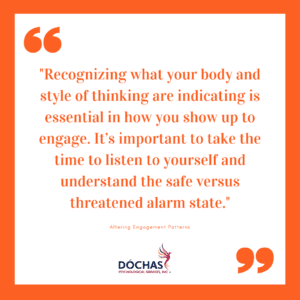Hey, it’s Paula here on the Dóchas blog! Are you finding it difficult to stay connected with your partner? Being in a relationship means engaging with another person, but sometimes the patterns of our engagement affect the quality of a relationship. If you’re responding out of stress or defensiveness, you might want to change your patterns so you and your partner experience a strong and close relationship. I’m here to help you better understand and give you some tips on altering engagement patterns.
Engaging with your partner is essential! And engagement is easy, fun, positive and energizing when you’re calm and within your window of tolerance. When you’re in this state you easily grasp the flow of information and process it, which allows you to think clearly, listen, respond, validate and ultimately connect. But when you’re outside your window of tolerance—when you’re experiencing stress—the way you engage with your partner is usually not so positive!
Why is this important?
Recognizing what your body and style of thinking are indicating is essential in how you show up to engage. It’s important to take the time to listen to yourself and understand the safe versus threatened alarm state. When we feel threatened, our emotional brain activates, causing us to react irrationally. That part of the brain does not respond to words, and the logic part of the brain dysregulates. When we feel like this, we tend not to listen or process information. The fight, flight or freeze (FFF) response is activated. Our brain activation impacts how we show up and engage in the world and with our partners.
You can imagine how acting out of a fight, flight or freeze mindset can make it tough to connect well with your partner!
Altering engagement patterns
If you don’t want to engage with your partner out of stress or defensiveness, you can alter it! A way of altering engagement patterns is putting in the work to get yourself into your calm state of mind. Another name for this calm state of mind is the Window of Tolerance, and it is a concept by Dr. Siegel, MD. It helps us understand the zone of “arousal” for a person to function and cope with their emotions in everyday life.
What does it mean to be out of your Window of Tolerance? Stress activation mode tends to look like this:
- Racing and/or looping thoughts
- Emotional overload (not responsive to words or logic)
- Heightened tone of voice (threatened, fight engaged)
- Defensiveness and blaming
- Body cues: muscles clenched, racing heart, heat sensations, sweaty palms, feeling restless, body language.
Put in the work
Learning how you show up to engage with your partner is one of the hardest parts. Learning to notice when you become activated is an essential feature to alter engagement patterns. The challenge comes with recognition and altering the pattern of how you show up when you are feeling dysregulated. It’s helpful to notice not only your response to certain feelings but also to notice when your partner may be activated in FFF. Yes, your partner can be outside of their Window of Tolerance too, and understanding that this is affecting how they respond to you can help you know why they’re engaging the way they are.
3 Steps you can take
How to alter your engagement pattern? Start with these three steps:
- Understand your own cues that can alert you to when you’re starting to feel dysregulated.
- Be honest with your partner about how you are feeling. For example, if your partner comments and your instinct is to defend, blame, and attack, it’s a sign that you’re dysregulated and not thinking clearly. Communicate this honestly.
- Understand your partner’s cues that indicate they are feeling dysregulated. Perhaps you’re engaging in a conversation and your partner is clenched up, with body language that indicates being frozen (in freeze mode). This may indicate that they are dysregulated and out of their window of tolerance! Another point of recognition is to notice your partner’s way of showing up.
It takes work and practice to implement strategies to get out of a dysregulated, stress-response state. My hope is to shed light on what may be happening from a neurobiological perspective, and explain what’s going on in the brain that leads to your pattern of engagement. It is possible to alter your pattern! If you found this helpful and would like to learn more about re-regulation, please don’t hesitate to reach out. If you need someone to talk to, we are here to listen.
In the meantime, please reach out and ask us how we can help. You can contact us here by calling us at 780-446-0300 or emailing info@dochaspsychologicalservices.com.
About Dóchas Psychological
Dóchas Psychological Services is a well-established and trusted therapy clinic located in Spruce Grove, Alberta. At Dóchas we value the idea that everyone deserves a safe space. Through connection and education, our team works hard to build a trustworthy relationship with each of our clients. It is our goal to create a community for our clients to feel like they belong.
Disclaimer
Information provided through Dóchas Psychological Services blogs or vlogs is meant for educational purposes only. They are NOT medical or mental health advice. You can read more about our disclaimer here.











